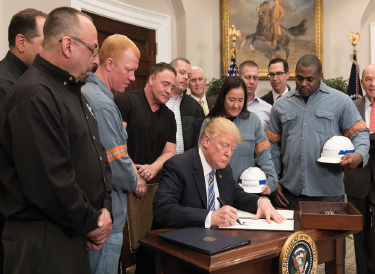
By Cassandra Sedler
Staff Writer
President Donald Trump recently announced his plan to impose tariffs on steel and aluminum imports. The statement relinquished a frenzy of panic among both Democratic and Republican officials alike.
Some argue the increase in tax could only lead us into a massive trade war. Trump’s announcement caused such a fear because it defies the globalist view that has been in practice for the last twenty or so years.
At a glance, it is no surprise Trump’s plan was met with gasps. However, Republicans should not be that caught off guard.
He is following through with the main point of his campaign agenda, and why many of his followers elected him in the first place. Trumps’ plan is not far off course from the actions of previous Republican presidents either.
For instance, in 1984, President Ronald Reagan introduced “voluntary restrained agreements” that were established to help U.S. steel manufacturers by decreasing the amount of steel imported. Similarly, President George W. Bush ordered a 30 percent increase in tariffs on most steel in 2002.
Bush’s tax was not enforced to promote American steel industries, but to give them a chance to adjust to rising imports. Nevertheless, the Republican ideology has maintained the same.
Under the guidelines of the World Trade Organization, a country cannot enforce new tariffs unless in the circumstance that national security is at stake. The main purpose of the increase in taxes is to protect U.S. national security and secure jobs in the steel and aluminum industries.
Instead of ridiculing the Trump administration out of what has now just become instinct, our country should take a breath, and consider for a second the logic behind the proposal. The plan would be a reciprocal tax, termed “America First,” as it will attempt to reduce imports of steel.
The truth is that the U.S. has low tariffs with a weighted trade average of 2.4 percent. Compared to some of our trading partners like China, that have a trade average of 4.4 percent.
In addition, “U.S. steel employment has dropped more than a third in the last two decades, while aluminum jobs shrank nearly 60 percent between 2013 and 2016” (npr.org).
Looking back in history when tariffs have been increased, a trade war was always feared, but little to no retaliation was ever inflicted by exporting countries. There is no ignoring the fact that the U.S. trade deficit has been at its greatest since 2008, according to data recently released by the government.
For this reason, perhaps now more than ever we need to start putting America’s needs first in terms of trading. Or, just try to hold back from having an immediate meltdown every time Trump speaks.
Email Cassandra at:
csedler@live.esu.edu

